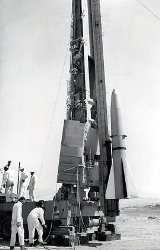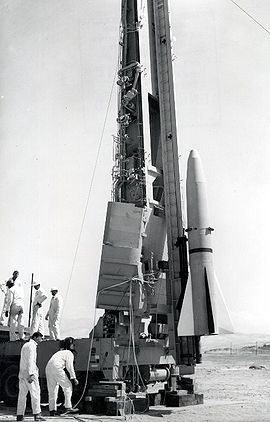
NOTS-EV-2 Caleb
Encyclopedia
The NOTS-EV-2 Caleb, also known as NOTS-500, Hi-Hoe and SIP was an expendable launch system
, which was later used as a sounding rocket
and prototype anti-satellite weapon
. It was developed by the United States
Navy Naval Ordinance Test Station (NOTS) as a follow-up to the NOTS-EV-1 Pilot
, which had been abandoned following ten consecutive launch failures. Two were launched in July and October 1960, before the cancellation of the project. Following cancellation, two leftover Calebs were used in the Satellite Interceptor Program, or SIP, whilst three more were used as sounding rocktets, under the designation Hi-Hoe. These derivatives flew until July 1962, when the Hi-Hoe made its final flight.
al launch system, to place small reconnaissance satellites, and other military payloads, into orbit at short notice. The orbital configurations were four-stage vehicles, whilst test launches used one and two stage configurations. The project was cancelled due to pressure from the United States Air Force
, who were responsible for all other orbital launches conducted by the US military, and no attempts to launch the vehicle into orbit were made.
Caleb was an air-launched rocket
, with its two launches being conducted from F4D Skyray
#747, the same aircraft used in the Pilot trials. Hi-Hoe was also air-launched, however it was released from an F4H Phantom II
, which provided greater performance. SIP launches were conducted from a ground launch pad on San Nicolas Island
. The aircraft used for the airborne launches took off from Point Arguello
, which later became part of Vandenberg Air Force Base
.
.
Both SIP launches used the two stage configuration. The first was conducted on 1 October 1961. It was successful and reached an apogee
of 20 kilometres (12.4 mi). The second test, launched on 5 May 1962 was also successful, and reached the same apogee. The three Hi-Hoe launches were conducted on 5 October 1961, and 26 March and 25 July 1962. On the first two launches the second stage failed to ignite, however the third was successful, and reached an apogee of 1166 kilometres (724.5 mi).
Despite the program's turn torwards success, the project was cancelled soon after the final Hi-Hoe test, the Department of Defense
choosing to concentrate on the U.S. Air Force's Blue Scout sounding rocket program.

Expendable launch system
An expendable launch system is a launch system that uses an expendable launch vehicle to carry a payload into space. The vehicles used in expendable launch systems are designed to be used only once , and their components are not recovered for re-use after launch...
, which was later used as a sounding rocket
Sounding rocket
A sounding rocket, sometimes called a research rocket, is an instrument-carrying rocket designed to take measurements and perform scientific experiments during its sub-orbital flight. The origin of the term comes from nautical vocabulary, where to sound is to throw a weighted line from a ship into...
and prototype anti-satellite weapon
Anti-satellite weapon
Anti-satellite weapons are designed to incapacitate or destroy satellites for strategic military purposes. Currently, only the United States, the former Soviet Union, and the People's Republic of China are known to have developed these weapons. On September 13, 1985, the United States destroyed US...
. It was developed by the United States
United States
The United States of America is a federal constitutional republic comprising fifty states and a federal district...
Navy Naval Ordinance Test Station (NOTS) as a follow-up to the NOTS-EV-1 Pilot
NOTS-EV-1 Pilot
The NOTS-EV-1 Pilot, also known as NOTSNIK was an expendable launch system and anti-satellite weapon developed by the United States Navy United States Naval Ordnance Test Station . Ten were launched during July and August 1958, all of which failed. It was the first air-launched rocket to be used...
, which had been abandoned following ten consecutive launch failures. Two were launched in July and October 1960, before the cancellation of the project. Following cancellation, two leftover Calebs were used in the Satellite Interceptor Program, or SIP, whilst three more were used as sounding rocktets, under the designation Hi-Hoe. These derivatives flew until July 1962, when the Hi-Hoe made its final flight.
Development
The Caleb was originally designed as a fast-response orbitOrbit
In physics, an orbit is the gravitationally curved path of an object around a point in space, for example the orbit of a planet around the center of a star system, such as the Solar System...
al launch system, to place small reconnaissance satellites, and other military payloads, into orbit at short notice. The orbital configurations were four-stage vehicles, whilst test launches used one and two stage configurations. The project was cancelled due to pressure from the United States Air Force
United States Air Force
The United States Air Force is the aerial warfare service branch of the United States Armed Forces and one of the American uniformed services. Initially part of the United States Army, the USAF was formed as a separate branch of the military on September 18, 1947 under the National Security Act of...
, who were responsible for all other orbital launches conducted by the US military, and no attempts to launch the vehicle into orbit were made.
Caleb was an air-launched rocket
Air launch to orbit
Air launch to orbit is the method of launching rocket launch vehicles at altitude from a horizontal-takeoff turbojet aircraft, either subsonic or supersonic...
, with its two launches being conducted from F4D Skyray
F4D Skyray
The Douglas F4D Skyray was an American carrier-based supersonic fighter/interceptor built by the Douglas Aircraft Company...
#747, the same aircraft used in the Pilot trials. Hi-Hoe was also air-launched, however it was released from an F4H Phantom II
F-4 Phantom II
The McDonnell Douglas F-4 Phantom II is a tandem two-seat, twin-engined, all-weather, long-range supersonic jet interceptor fighter/fighter-bomber originally developed for the United States Navy by McDonnell Aircraft. It first entered service in 1960 with the U.S. Navy. Proving highly adaptable,...
, which provided greater performance. SIP launches were conducted from a ground launch pad on San Nicolas Island
San Nicolas Island
San Nicolas Island is the most remote of California's Channel Islands. It is part of Ventura County. The 14,562 acre island is currently controlled by the United States Navy and is used as a weapons testing and training facility, served by Naval Outlying Field San Nicolas Island...
. The aircraft used for the airborne launches took off from Point Arguello
Point Arguello
Point Arguello is a headland used as a launch site by the United States Navy. Point Arguello was first used in 1959 for the launch of military and sounding rockets. It was transferred to the United States Air Force in 1964, at which time it became part of Vandenberg Air Force Base.There were 6...
, which later became part of Vandenberg Air Force Base
Vandenberg Air Force Base
Vandenberg Air Force Base is a United States Air Force Base, located approximately northwest of Lompoc, California. It is under the jurisdiction of the 30th Space Wing, Air Force Space Command ....
.
Operational history
The Caleb made its maiden flight, in a single-stage test configuration, on 28 July 1960. Its second flight was made on 24 October of the same year, and used a two-stage configuration. It was unsuccessful, due to the second stage's failure to ignite. Both test launches were suborbitalSub-orbital spaceflight
A sub-orbital space flight is a spaceflight in which the spacecraft reaches space, but its trajectory intersects the atmosphere or surface of the gravitating body from which it was launched, so that it does not complete one orbital revolution....
.
Both SIP launches used the two stage configuration. The first was conducted on 1 October 1961. It was successful and reached an apogee
Apsis
An apsis , plural apsides , is the point of greatest or least distance of a body from one of the foci of its elliptical orbit. In modern celestial mechanics this focus is also the center of attraction, which is usually the center of mass of the system...
of 20 kilometres (12.4 mi). The second test, launched on 5 May 1962 was also successful, and reached the same apogee. The three Hi-Hoe launches were conducted on 5 October 1961, and 26 March and 25 July 1962. On the first two launches the second stage failed to ignite, however the third was successful, and reached an apogee of 1166 kilometres (724.5 mi).
Despite the program's turn torwards success, the project was cancelled soon after the final Hi-Hoe test, the Department of Defense
United States Department of Defense
The United States Department of Defense is the U.S...
choosing to concentrate on the U.S. Air Force's Blue Scout sounding rocket program.
Launch history
| Date/Time (GMT) | Rocket | S/N Serial number A serial number is a unique number assigned for identification which varies from its successor or predecessor by a fixed discrete integer value... |
Outcome | Remarks |
|---|---|---|---|---|
| 1960-07-28 | Caleb | TV-1 | Success | Single stage |
| 1960-10-24 | Caleb | TV-2 | Failure | Second stage failed to ignite |
| 1961-10-01 | SIP | SIP-1 | Success | Ground launch |
| 1961-10-05, 19:10 | Hi-Hoe | NC17.116 | Failure | Second stage failed to ignite |
| 1962-03-26, 19:03 | Hi-Hoe | NC17.121 | Failure | Second stage failed to ignite |
| 1962-05-05 | SIP | SIP-2 | Success | Ground launch |
| 1962-07-25, 15:41 | Hi-Hoe | NC17.117 | Success |
See also


